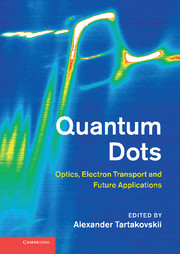Book contents
- Frontmatter
- Contents
- List of contributors
- Preface
- Part I Nanostructure design and structural properties of epitaxially grown quantum dots and nanowires
- Part II Manipulation of individual quantum states in quantum dots using optical techniques
- Part III Optical properties of quantum dots in photonic cavities and plasmon-coupled dots
- Part IV Quantum dot nano-laboratory: magnetic ions and nuclear spins in a dot
- Part V Electron transport in quantum dots fabricated by lithographic techniques from III–V semiconductors and graphene
- Part VI Single dots for future telecommunications applications
- 18 Electrically operated entangled light sources based on quantum dots
- 19 Deterministic single quantum dot cavities at telecommunication wavelengths
- Index
- References
19 - Deterministic single quantum dot cavities at telecommunication wavelengths
from Part VI - Single dots for future telecommunications applications
Published online by Cambridge University Press: 05 August 2012
- Frontmatter
- Contents
- List of contributors
- Preface
- Part I Nanostructure design and structural properties of epitaxially grown quantum dots and nanowires
- Part II Manipulation of individual quantum states in quantum dots using optical techniques
- Part III Optical properties of quantum dots in photonic cavities and plasmon-coupled dots
- Part IV Quantum dot nano-laboratory: magnetic ions and nuclear spins in a dot
- Part V Electron transport in quantum dots fabricated by lithographic techniques from III–V semiconductors and graphene
- Part VI Single dots for future telecommunications applications
- 18 Electrically operated entangled light sources based on quantum dots
- 19 Deterministic single quantum dot cavities at telecommunication wavelengths
- Index
- References
Summary
Scalability requirements in future device application of self-assembled quantum dots for non-classical light generation necessitate control of the quantum dot nucleation site. In this chapter we discuss a site-control technique based on directed self-assembly of InAs/InP quantum dots emitting at telecommunication wavelengths. The site-control method preserves the high optical quality inherent in self-assembled quantum dots and the characteristic signatures of a strongly confined system are observed in the emission spectra. The efficacy of site-control manifests in the coupling of single quantum dots to microcavities required for the fabrication of efficient devices. The a priori knowledge of the quantum dot position is used to deterministically couple single dots to high-finesse microcavities with the assurance that one and only one quantum dot is coupled to each cavity. Such devices form the basis of efficient sources of single photons and entangled photon pairs for telecommunications applications that can be manufactured in a scalable manner using conventional semiconductor processing.
Introduction
Self-assembled quantum dots possess the two-level emitter characteristics required for non-classical light generation [37] in quantum information processing and quantum key distribution. The performance of a quantum dot-based single photon source or entangled photon pair source will depend on how well the dot can be coupled to a high-quality factor Q, small volume Veff microcavity [44]. The cavity is required to channel photons from the exciton decay into an optical mode that can be collected by an external optical system.
- Type
- Chapter
- Information
- Quantum DotsOptics, Electron Transport and Future Applications, pp. 341 - 355Publisher: Cambridge University PressPrint publication year: 2012



